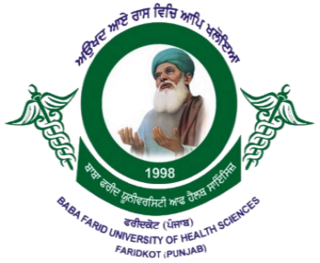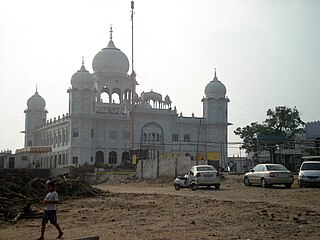
Punjabi University is a collegiate state public university located in Patiala, Punjab, India. It was established on 30 April 1962 and is only the second university in the world to be named after a language, after Hebrew University of Israel. Originally it was conceived as a unitary multi-faculty teaching and research university, primarily meant for the development and enrichment of the Punjabi language and culture, but alive to the social and education requirements of the state.

Mata Gujri, also known as Mata Gujari, was the wife of Guru Tegh Bahadur, the ninth Guru of Sikhism, and the mother of Guru Gobind Singh, the tenth Guru of Sikhism.

Jorawar Singh was the third of Guru Gobind Singh's four sons. He and his younger brother, Fateh Singh are among the most hallowed martyrs in Sikhism.

Jujhar Singh, the second son of Gobind Singh, was born to Mata Jito at Anandpur Sahib. This event is now celebrated on April 9 each year according to the Nanakshahi Calendar.

Baba Farid University of Health Sciences was established in July 1998 by Punjab Act No. 18. It is named after Baba Farid, a 12th-century Punjabi sufi, and headquartered in Faridkot.

Nada Sahib is a Sikh gurudwara in the Panchkula district of the Indian state of Haryana. Situated on the banks of the Ghaggar-Hakra River in the Sivalik Hills of Panchkula, it is the site where Guru Gobind Singh Ji halted while travelling from Paonta Sahib to Anandpur Sahib after the Battle of Bhangani in 1688.

Lakhi Jungle is a village in the district of Bathinda in Punjab, India. It is situated 15 km from the city of Bathinda, on the way to Muktsar. In the 17th century, the Sikhs used the surrounding jungle as a hideout from persecution by the Mughal Empire and the Duranni Empire. The jungle itself has mostly been deforested. The ninth Sikh Guru, Guru Teg Bahadur and tenth Sikh Guru, Guru Gobind Singh visited this place. The historic Gurdwara Lakhi Jungle Sahib is located on the outskirts of the village.

The Battle of Chamkaur, also known as Battle of Chamkaur Sahib, was a battle fought between the Khalsa, led by Guru Gobind Singh, and the coalition forces of the Mughals led by Wazir Khan and of Hindu hill chief. Guru Gobind Singh makes a reference to this battle in his letter Zafarnama.
Deg Teg Fateh is a Sikh slogan and the title of an anthem in the Punjabi language that signifies the dual obligations of the Khalsa: The responsibility to provide food, and to provide protection, for the needy and oppressed.

The Panjab Digital Library is a voluntary organization digitizing and preserving the cultural heritage of Panjab since 2003. With over 45 million digitized pages, it is the biggest resource of digital material on Panjab. There are many historically significant documents stored and made available online. Its scope covers Sikh and Punjabi culture. The library funded by The Nanakshahi Trust was launched online in August 2009. Its base office is located at Chandigarh, India.

Mātā Sundarī was the daughter of Ram Sarana, a Punjabi Soni Kumarāv Khatri of Bijwara Soni - in present-day Hoshiārpur district. She was the wife of Guru Gobind Singh. After the martyrdom of her children, she adopted a son named Ajit Singh who was later killed on a false accusation that he had killed a Muslim dervish.

Banda Singh Bahadur, was a Sikh warrior and a commander of Khalsa army. At age 15, he left home to become an ascetic, and was given the name Madho Das Bairagi. He established a monastery at Nānded, on the bank of the river Godāvarī. In 1707, Guru Gobind Singh accepted an invitation to meet Bahadur Shah I in southern India. He visited Banda Singh Bahadur in 1708. Banda became disciple of Guru Gobind Singh and was given a new name, Gurbaksh Singh(as written in mahan kosh), after the baptism ceremony. He is popularly known as Banda Singh Bahadur. He was given five arrows by the Guru as a blessing for the battles ahead. He came to Khanda in Sonipat and assembled a fighting force and led the struggle against the Mughal Empire.
Harbans Singh was an educationist, administrator, scholar and the editor-in-chief of the Encyclopaedia of Sikhism. He was respected for his contributions to Sikh scholarship and Punjabi literary studies and had a vital and pervasive influence in the field of religious studies, with special reference to Sikhism.

Nirmala is a Sikh sect of ascetics. According to the traditional beliefs, the Sanatan Nirmala Sikh tradition was founded by Guru Gobind Singh in late 17th century when he sent five Sikhs to Varanasi to learn Sanskrit and Vedanta texts.

The Jathedar of the Akal Takht is the appointed head of the Akal Takht and the Sikhs of the world. Sikh clergy consists of five Jathedars, one each from five Takhts.
Punjabi University Guru Kashi Campus (PUGKC) is regional centre of Punjabi University, located at Talwandi Sabo. Its main constituents are Yadavindra College of Engineering, University School of Business Studies and Punjabi University Guru Kashi College.

Trilok Singh Chitarkar (1914-1990) was a versatile Indian painter. He has unique style of presenting himself through variety of themes - Sikh religion, history, culture, folk lore, love legends, portraits, social evils, nature, illustration of Gurbani, Shabads, visuals in Punjabi Encyclopedia and books. He was well versed with deep knowledge of Gurbani, history and religion. He knew many languages i.e. Gurmukhi, Punjabi, Hindi, English, Urdu, Persian, Assamese and Bengali. He translated articles from Bengali to Punjabi and published these in the book titled Bangla De Daab in 1974. The Artist was honoured in 1973 by the Chief Minister, Punjab,India Giani Zail Singh at a state level function organised at his residence, Chitralok, Patiala. Language department, Punjab published a book in Punjabi-Chitralok's Contribution to Art and released on the 70th birthday of the artist, December 10, 1984 at a special function organised in Central Library at Patiala for his contribution to Art.
He is the first Punjabi Artist on whose works Ph.D. degree Art of Trilok Singh was awarded by Punjabi University, Patiala. A Gold medal has been established in the name of the artist and it is awarded to the topper of M.A. Fine Arts. He was appointed as a State Artist in erstwhile PEPSU state of Punjab in 1948 and later worked as Artist in Department of Languages, Punjab. He lived and worked all over India and spent last years of his life in Patiala town in Punjab state in India.













